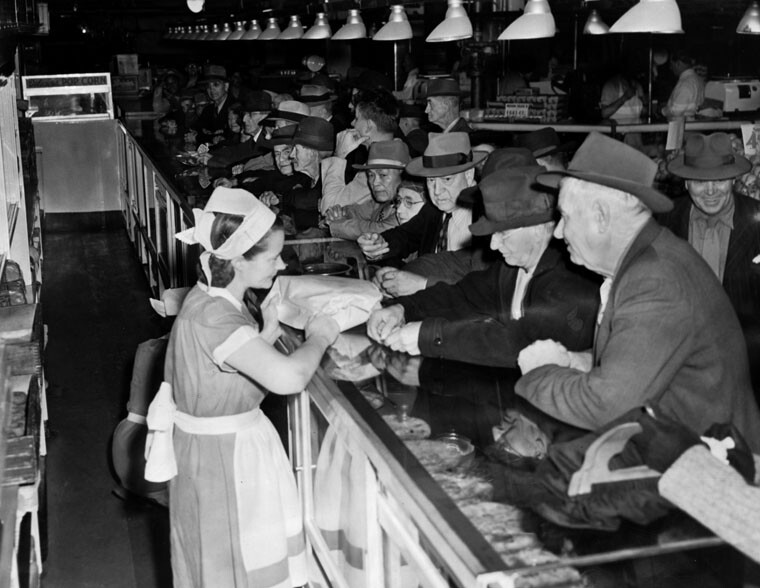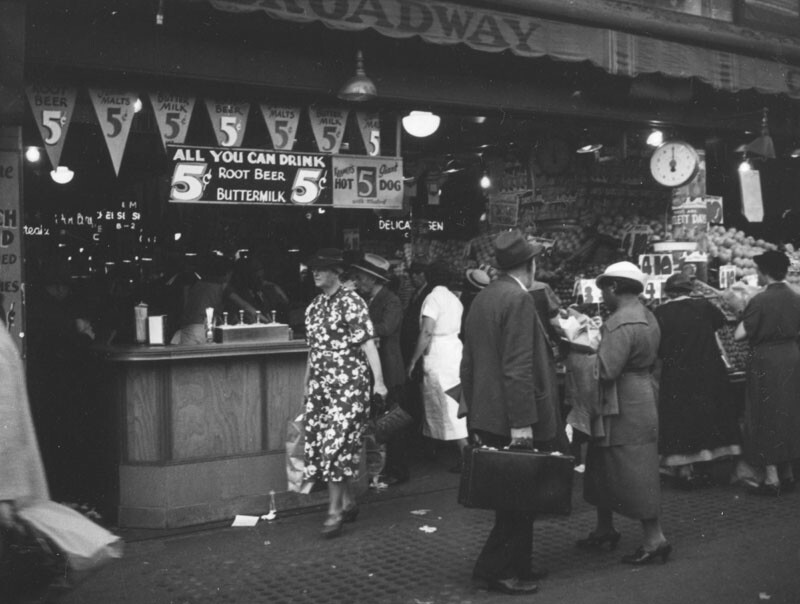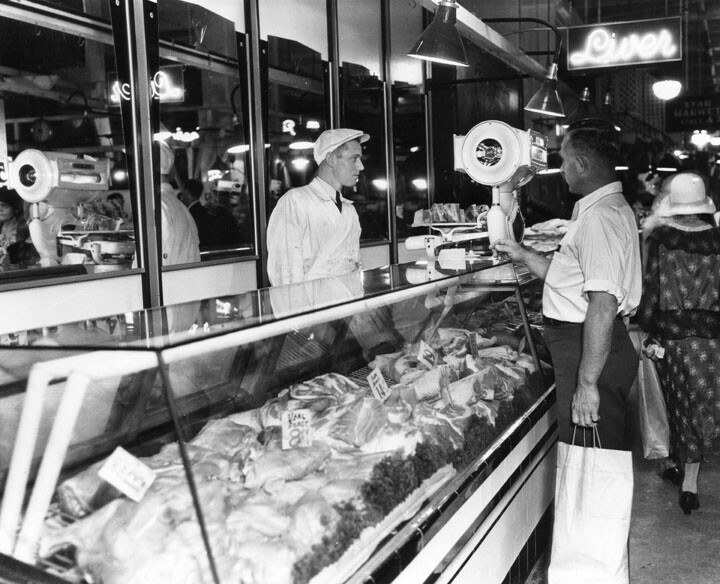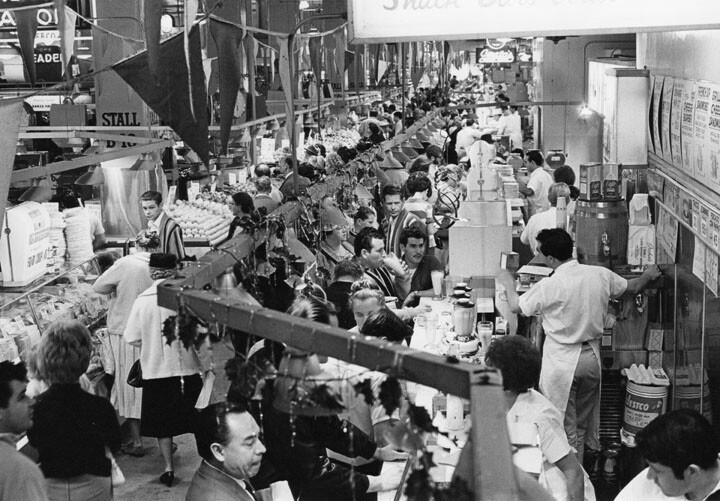A Scene of Lively Activity: Grand Central Market, Then and Now

"People in Los Angeles have not acquired the market habit to the extent that people in most other large cities have. On this coast, both San Francisco and Seattle have had large and well patronized markets for years, but here we have been slow about getting them. The Grand Central Market is designed to change this condition." -- Homer Laughlin Jr., 1917
"You can learn a great deal about life as well as about living at the Grand Central Market." -- L.A. Times, December 11, 1928
In July of 1898, a new commercial building of "elegant office rooms" and retail space was opened at 317 Broadway, the hub and heart of downtown Los Angeles. It was built by a man named Homer Laughlin, and designed by famed L.A. architect John Parkinson. The Beaux Arts-style, "absolutely fire-proof" structure promised "plenty of fresh air and sunshine in every room," as well as "unequalled janitor, heating, electric, lighting, hot and cold water services." The building's offices were inhabited by socially important groups such as the Red Cross and the School Board. The retail spaces were home to shops like "the Ladies Tailoring Company," which offered silk-lined jackets made from imported cloth. Perfectly located across the street from Angeles Flight and the well-to-do homes on Bunker Hill, the building was massively expanded to Hill Street, in 1905, to make way for "Ville de Paris," a large dry goods store that aimed to be the next Marshall Fields. Bustling Ville de Paris occupied the ground floor, whose extension was built on a gradual incline, making it possible to see all over the store.
As the population of Los Angeles exploded in the early 20th century, Angeleno leaders increasingly focused on building institutions and public spaces that would make L.A. a first class city, on par with imagined rivals in the East and Northwest. One of the things Los Angeles lacked was a grand produce center -- which many considered ludicrous, given California's fertile fields and abundant crops. In 1917, Homer Laughlin Jr. teamed with noted market man C.A. Goss to open Grand Central Market on the ground floor of the Laughlin Building, the same space once occupied by the "Ville de Paris,"(which had moved to a new location). The Los Angeles Times lauded the space, which would have "every kind of food product" one could think of:

"Many merchants have already signed leases for quarters in the market and the place will present a scene of lively activity from the day it is thrown open to the public. The market will be the largest and best equipped of its kind on the coast. More than 72,000 square feet of floor space are being utilized for the erection of stalls and booths for commodious aisles and promenades. The great room is a block depth extending from Broadway to Hill and having attractive entrances on each of these thoroughfares. Among the conveniences provided will be an information bureau and checkroom for visitors and patrons, a ladies roast-room and a drinking fountain set in a bower of Cyprus trees and greenery. A fully equipped refrigerator system is being installed for the keeping of all perishable products. The basement will be given over to the use of farmers and gardeners for the display and marketing of fresh products from the fields." -- Los Angeles Times, October 21, 1917
The market quickly became a mecca for Angelenos of all backgrounds, as well as a source of great civic pride. By 1926, an estimated forty thousand people flooded the 120 stalls of the gargantuan market daily from 8am to 10pm. Many of the vendors were recent immigrants, "The Japanese flower and produce men, the German chef, the Italian cheese vender and the American grocer, all doing business side by side," said the L.A. Times in 1926.

The patrons were often housewives: from those in the comfortable middle-class to the "less fortunate sister" who had to content herself with shopping in the basement, where the cheaper grade of goods was kept. For wealthier women, these weekly visits to the market were "always anticipated with a certain amount of pleasure" because she could eat a meal she had not cooked herself, and socialize with friends at one of the numerous lunch counters or restaurants within the sprawling complex. The meat was plentiful: there were no fewer than fourteen butcher shops. The fresh, generally high quality produce was consistently sold a few cents cheaper than anywhere else in Los Angeles. A visitor to the market noted, in a 1926 L.A. Times article:
"Mountains of head lettuce, watercress, spinach, beets, shiny carrots, red radishes, and fresh young onions intermingled with splashes of brighter colors from floral and fruit booths, overcrowded aisles and a seething mass of elbowing, pushing humanity, laden down with shopping bags-that is a bird's eye description of one of the largest markets in the world, the Grand Central Market of Los Angeles, which feeds millions of people annually. Every sort of fruit as well as every kind of vegetable grown in Southern California can be purchased here throughout the year. There are, for instance, great quantities of yellow loquats, persimmons, pomegranates, peaches, guavas, oranges, avocados, grapefruit, the lowly apple and all the various kinds of berries that help to make one feel, indeed, as if looking into the proverbial horn of plenty which has so long been consider symbolic of California."

Tourists flocked to the market, buying candied nuts and fruits from Mr. Goss's booth, or perhaps purchasing Flaxolyn, a "harmless natural food laxative," from Jones Grain Mill after they had eaten too many slices of Swift's Premium Ham, on sale at Fox Stall B-2 for 45 cents. Competition between various outlets led to some innovative marketing practices. There was one stall with a sign that read "DON'T STEAL THE GARLIC," to subliminally remind busy businessmen that they sold garlic, just in case their wives asked them to pick it up on the way home from work. Competition also led to some unethical practices, and stall owners were often arrested and fined for displaying large bell peppers or tomatoes, only to bag smaller and less appealing specimens for customers. The Depression and World War II presented their own challenges to the market. The scarcity of meat during the War caused customers to swamp butcher shops whenever they were rumored to have received fresh meat.
Grand Central's retailers and regular customers dramatically shifted along with the changing demographics and growing economic depression of post-war downtown. In 1960, the market was said to have over 250,000 customers each week, and food products from 95 countries. The market had its share of colorful characters, like the man begging outside the market who was found to have over $8000 spread about his person, and the blind man who sold pens. He wore a hat that stated, "they write the best love letters." The Laughlin building became dominated by the market: its upstairs space was largely vacant for years.

The market itself was reinvigorated by a large population of recent immigrants from Mexico and Latin America who moved into the area. By 1968, the proliferation of supermarkets and farmers markets around L.A. had made Grand Central Market a more local affair, with 52 stalls catering primarily to lower income families who lived nearby. Market master Harold Abbot explained to the Times, "We cater to laboring people with large families who want quantity rather than quality, although some of our food is as good a quality as any."
"Bargain meat" like lamb heads and turkey tails shared space with kosher burritos. By 1978, the L.A. Times estimated that around half of the 180,000 weekly shoppers at the market were of Latino descent. A visiting journalist explained:
"The current flavor of the market is Chicano although the produce is distinctly Cosmopolitan- Polish hams, Italian handmade sausage, Japanese chili, Holland edam cheese, German quality wieners, California seedless grapes, Jewish salami and every kind of rice and bean."

Grand Central was more of a meeting place than ever for its regular customers; a place to socialize with people who spoke your language and understood your culture. It was a frequent stomping ground for politicians on the campaign trail, who saw it as a valuable place to meet and be photographed with constituents. It was a place to find exotic foods like baked lamb heads, soft tacos with beef cheeks or brains, and "the most tantalizing assortment of richly colored chili peppers north of the Mexican border." (L.A. Times, 1985.) Vendors supplied affordable, healthy food to struggling families by selling day-old bread, and past "sell-by date" produce. In 1985, it was estimated that food stamp purchases made up 20 percent of sales at the market. That same year, the market was bought by Beverly Hills attorney Ira Yellin, and for over 20 years he and his family lovingly ran the market with an eye toward preservation and sustainability.
The past ten years have seen the resurgence of downtown as a place of hip, trendy businesses and wealthy, progressive residents. With some of the best restaurants in the country now calling downtown Los Angeles home, it is not surprising that the market, now guided by Ira's widow, Adele, has suddenly become a nationally recognized hot spot, featuring notable eateries like Eggslut, Horse Thief, Belcampo Meat Company, Sticky Rice, and Wexler's Deli. This year, irony abounded when Bon Appétit voted the entire market one of the "best new restaurants" of 2014. As Grand Central Market welcomes new, trendy tenants, one hopes they do not abandon the vendors and customers who kept the market afloat for so many years. After all, variety is the spice of life.


